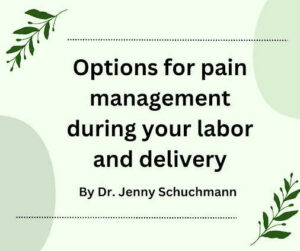
Patients often ask which method of pain management I recommend during their labor and delivery. There are many factors that impact how you may feel during labor, and it is impossible to predict how you will feel in the moment. It is a good idea to think about what your wishes are for pain management prior to having your baby. However, it is okay to be unsure or to change your mind when you are in the hospital! Your labor and delivery nurse and delivery provider will be happy to answer any questions that you have about options for pain management.
There are some common misconceptions about pain management during labor. It is important to know that using pain medication does not increase your likelihood of having a c-section. Also, pain medications used in labor do not cause any long-term effects on the baby. Having a medicated delivery does not significantly “slow down” or prolong how long you are in labor.
IV pain medication (opioids)
- Administered by a nurse through an IV
- Can affect your baby’s breathing temporarily if given close to when the baby is delivered. As a result, we sometimes hold IV medications as you get close to your baby being born. These meds do not cause long-term effects on your baby.
- I always tell patients that IV meds work quickly, but not forever. Sometimes women will need multiple doses of an IV medication
Regional anesthesia (epidural)
- An epidural is the most common type of pain relief during childbirth used in the United States
- A needle is inserted into your lower back. A thin tube is then inserted through it and the needle is withdrawn. Medication is released continuously through the tube to provide long-term pain relief
- A patient experiences some loss of feeling in the lower areas of her body
- A common misconception is that you must be a certain number of centimeters dilated to have an epidural. I tell my patients that they are the only one who knows how much pain she is in. You can ask for an epidural whenever you feel that you would benefit from it.
- Another question patients ask is “When is it too late to get an epidural”? If you can sit still long enough for an epidural to be placed (several minutes), then you can have one!
- You can move with an epidural but will not be able to walk. We still have patients labor in different positions even though they cannot get out of bed.
- Epidurals can also help after you have the baby – for example, they will continue to provide pain relief if you have a tear from childbirth and need stitches.
Nitrous oxide (laughing gas)
- Not available at all hospitals
- Tasteless and odorless gas
- You hold the mask to your face when needed
- Okay to use at any point during your labor
- Does not numb pain, but can reduce anxiety and increase a feeling of well-being
Non-medical pain relief
- Focus is on relaxation and coping with pain. It can involve finding support from others (family, friends, nursing staff, a doula, or medical providers). Some examples are:
- Relaxation and breathing techniques
- Changing positions often
- Using a labor ball to sit/bounce on
- Walking in your room or the hallway
- When contractions are closer together and stronger, rest in between and take slow, deep breaths
We support our patients in making an informed decision that they feel is best for them. At one of your doctor’s appointments or childbirth classes, you may want to discuss which options are available at the hospital you plan to deliver. Our providers are happy to visit with you and answer any questions you may have about pain management options.
We are accepting new patients! To schedule an appointment with OBGYN Associates, call us at 515-288-3287.
DISCLAIMER: All information on this website is provided for informational purposes only and is not intended to be construed as medical advice. OBGYN Associates shall not be liable for any errors or inaccuracies contained herein, or any actions taken in reliance thereon.

Patients often ask which method of pain management I recommend during their labor and delivery. There are many factors that impact how you may feel during labor, and it is impossible to predict how you will feel in the moment. It is a good idea to think about what your wishes are for pain management prior to having your baby. However, it is okay to be unsure or to change your mind when you are in the hospital! Your labor and delivery nurse and delivery provider will be happy to answer any questions that you have about options for pain management.
There are some common misconceptions about pain management during labor. It is important to know that using pain medication does not increase your likelihood of having a c-section. Also, pain medications used in labor do not cause any long-term effects on the baby. Having a medicated delivery does not significantly “slow down” or prolong how long you are in labor.
IV pain medication (opioids)
- Administered by a nurse through an IV
- Can affect your baby’s breathing temporarily if given close to when the baby is delivered. As a result, we sometimes hold IV medications as you get close to your baby being born. These meds do not cause long-term effects on your baby.
- I always tell patients that IV meds work quickly, but not forever. Sometimes women will need multiple doses of an IV medication
Regional anesthesia (epidural)
- An epidural is the most common type of pain relief during childbirth used in the United States
- A needle is inserted into your lower back. A thin tube is then inserted through it and the needle is withdrawn. Medication is released continuously through the tube to provide long-term pain relief
- A patient experiences some loss of feeling in the lower areas of her body
- A common misconception is that you must be a certain number of centimeters dilated to have an epidural. I tell my patients that they are the only one who knows how much pain she is in. You can ask for an epidural whenever you feel that you would benefit from it.
- Another question patients ask is “When is it too late to get an epidural”? If you can sit still long enough for an epidural to be placed (several minutes), then you can have one!
- You can move with an epidural but will not be able to walk. We still have patients labor in different positions even though they cannot get out of bed.
- Epidurals can also help after you have the baby – for example, they will continue to provide pain relief if you have a tear from childbirth and need stitches.
Nitrous oxide (laughing gas)
- Not available at all hospitals
- Tasteless and odorless gas
- You hold the mask to your face when needed
- Okay to use at any point during your labor
- Does not numb pain, but can reduce anxiety and increase a feeling of well-being
Non-medical pain relief
- Focus is on relaxation and coping with pain. It can involve finding support from others (family, friends, nursing staff, a doula, or medical providers). Some examples are:
- Relaxation and breathing techniques
- Changing positions often
- Using a labor ball to sit/bounce on
- Walking in your room or the hallway
- When contractions are closer together and stronger, rest in between and take slow, deep breaths
We support our patients in making an informed decision that they feel is best for them. At one of your doctor’s appointments or childbirth classes, you may want to discuss which options are available at the hospital you plan to deliver. Our providers are happy to visit with you and answer any questions you may have about pain management options.
We are accepting new patients! To schedule an appointment with OBGYN Associates, call us at 515-288-3287.
DISCLAIMER: All information on this website is provided for informational purposes only and is not intended to be construed as medical advice. OBGYN Associates shall not be liable for any errors or inaccuracies contained herein, or any actions taken in reliance thereon.





Leave A Comment